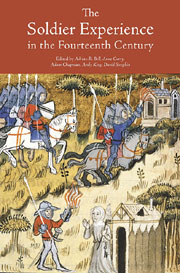Book contents
- Frontmatter
- Contents
- List of Contributors
- List of Abbreviations
- Introduction
- 1 Military Service and the Dynamics of Recruitment in Fourteenth-Century England
- 2 Total War in the Middle Ages? The Contribution of English Landed Society to the Wars of Edward I and Edward II
- 3 A Warlike People? Gentry Enthusiasm for Edward I's Scottish Campaigns, 1296–1307
- 4 Edward I's Centurions: Professional Soldiers in an Era of Militia Armies
- 5 Who's afraid of the Big Bad Bruce? Balliol Scots and ‘English Scots’ during the Second Scottish War of Independence
- 6 Rebels, Uchelwyr and Parvenus: Welsh Knights in the Fourteenth Century
- 7 Breton Soldiers from the Battle of the Thirty (26 March 1351) to Nicopolis (25 September 1396)
- 8 Towards a Rehabilitation of Froissart's Credibility: The Non Fictitious Bascot de Mauléon
- 9 The English Reversal of Fortunes in the 1370s and the Experience of Prisoners of War
- 10 The Soldier, ‘hadde he riden, no man ferre’
- Index
- Warfare in History
2 - Total War in the Middle Ages? The Contribution of English Landed Society to the Wars of Edward I and Edward II
Published online by Cambridge University Press: 05 February 2013
- Frontmatter
- Contents
- List of Contributors
- List of Abbreviations
- Introduction
- 1 Military Service and the Dynamics of Recruitment in Fourteenth-Century England
- 2 Total War in the Middle Ages? The Contribution of English Landed Society to the Wars of Edward I and Edward II
- 3 A Warlike People? Gentry Enthusiasm for Edward I's Scottish Campaigns, 1296–1307
- 4 Edward I's Centurions: Professional Soldiers in an Era of Militia Armies
- 5 Who's afraid of the Big Bad Bruce? Balliol Scots and ‘English Scots’ during the Second Scottish War of Independence
- 6 Rebels, Uchelwyr and Parvenus: Welsh Knights in the Fourteenth Century
- 7 Breton Soldiers from the Battle of the Thirty (26 March 1351) to Nicopolis (25 September 1396)
- 8 Towards a Rehabilitation of Froissart's Credibility: The Non Fictitious Bascot de Mauléon
- 9 The English Reversal of Fortunes in the 1370s and the Experience of Prisoners of War
- 10 The Soldier, ‘hadde he riden, no man ferre’
- Index
- Warfare in History
Summary
The association between landholding, wealth and military obligation in the Middle Ages has been a much studied subject. It is axiomatic that in an age before the rise of professional, standing armies the successful recruitment of large numbers of soldiers, both mounted and foot, depended, in the main, on the exploitation of essentially private resources, both material and human. In other words, warfare in the Middle Ages was a collective private enterprise that could, through the muster process and (at least from the later fourteenth century) the issuing of military ordinances be made into a centrally controlled public enterprise for the duration of a campaign, usually a few weeks or months. It is one thing, however, to know that the mounted arm of medieval armies comprised large numbers of privately assembled companies (military retinues) brought together from the localities, but quite another to know how these retinues were assembled and the nature of the social and landholding ties that underpinned them. In order to analyse more closely the influence that local, regional and landholding ties had on retinue composition it is necessary to have access both to detailed sources that shed light on the identities of landholders within a kingdom, on the one hand, and to sources that record the names of large numbers of soldiers serving in the armies of the same realm, on the other.
- Type
- Chapter
- Information
- The Soldier Experience in the Fourteenth Centur , pp. 61 - 94Publisher: Boydell & BrewerPrint publication year: 2011



